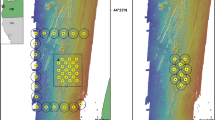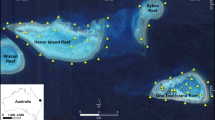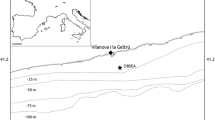Abstract
Passive acoustic telemetry and conventional tag/re-sight techniques were used to study daily movement patterns of adult yellow tang, Zebrasoma flavescens, over a period of months. Range testing and visual observations revealed the limitations of using small acoustic transmitters to monitor movements of small coral reef fish in a topographically complex and noisy coral reef environment. Visual observations of conventionally tagged and albino fish suggest individuals return each day to forage over the same few hundred m2 of shallow, turf algae dominated boulder and reef flat habitat for periods of at least weeks to months. Acoustic telemetry data suggest lower frequency of repeated use of daytime foraging, nighttime refuge and sunset spawning sites. However, integration of observation and acoustic telemetry data revealed that many fish were not detected while they were within the empirically tested range of the receivers. These observations indicate that data from passive acoustic telemetry can underestimate the frequency and duration of repeated use of specific areas. Yellow tang adults made daily crepuscular migrations of up to 600 m between foraging and spawning or sheltering sites at consistent times relative to sunset and sunrise. While there was high individual variability in migration distance, almost all individuals moved in the same direction (from south to north) at sunset. This study provided valuable information for evaluating ongoing fishery management efforts using marine protected areas in Hawaii.







Similar content being viewed by others
References
Afonso P, Fontes J, Holland KN, Santos RS (2008) Social status determines behaviour and habitat usage in a temperate parrotfish: implications for marine reserve design. Mar Ecol Prog Ser 359:215–227
Atkins P (1981) Behavioral determinants of the nocturnal spacing pattern of the yellow tang Zebrasoma flavescens (Acanthuridae). Pac Sci 35:263–264
Au WWL, Banks K (1998) The acoustics of the snapping shrimp Synalpheus parneomeris in Kaneohe Bay. J Acoust Soc Am 103:41–47
Botsford L, Brumbaugh D, Grimes C, Kellner J, Largier J, O’Farrell M, Ralston S, Soulanille E, Wespestad V (2009) Connectivity, sustainability, and yield: bridging the gap between conventional fisheries management and marine protected areas. Rev Fish Biol Fish 19:69–95
Bushnell ME, Claisse JT, Laidley CW (2010) Lunar and seasonal patterns in fecundity of an indeterminate, multiple-spawning surgeonfish, the yellow tang Zebrasoma flavescens. J Fish Biol 76:1343–1361
Chapman MR, Kramer DL (2000) Movements of fishes within and among fringing coral reefs in Barbados. Environ Biol Fish 57:11–24
Claisse JT (2009) The life history and movements of yellow tang, Zebrasoma flavescens, with implications for fisheries management using protected areas., PhD dissertation, University of Hawaii at Manoa, Honolulu, HI, Honolulu, HI
Claisse JT, Kienzle M, Bushnell ME, Shafer DJ, Parrish JD (2009) Habitat- and sex-specific life history patterns of yellow tang Zebrasoma flavescens in Hawaii, USA. Mar Ecol Prog Ser 389:245–255
Eklund A, Schull J (2001) A stepwise approach to investigating the movement patterns and habitat utilization of goliath grouper, Epinephelus itajara, using conventional tagging, acoustic telemetry and satellite tracking. In: JRSaJL N (ed) Electronic tagging and tracking in marine fisheries. Kluwer Academic, Netherlands, pp 189–216
Frederick JL (1997) Evaluation of fluorescent elastomer injection as a method for marking small fish. Bull Mar Sci 61:399–408
Friedlander A, Aeby G, Brainard R, Brown E, Chaston K, Clark A, McGowan P, Montgomery T, Walsh W, Williams I, Wiltse W (2008) The state of coral reef ecosystems of the Main Hawaiian Islands. NOAA/NCOS Center for Coastal Monitoring and Assessment, Biogeography Branch, Silver Spring, MD
Heupel MR, Semmens JM, Hobday AJ (2006) Automated acoustic tracking of aquatic animals: scales, design and deployment of listening station arrays. Mar Freshwat Res 57:1–13
Heupel MR, Reiss KL, Yeiser BG, Simpfendorfer CA (2008) Effects of biofouling on performance of moored data logging acoustic receivers. Limnol Oceanogr Meth 6:327–335
Kawabata Y, Okuyama J, Asami K, Yoseda K, Arai N (2008) The post-release process of establishing stable home ranges and diel movement patterns of hatchery-reared black-spot tuskfish Choerodon schoenleinii. J Fish Biol 73:1770–1782
Kramer DL, Chapman MR (1999) Implications of fish home range size and relocation for marine reserve function. Environ Biol Fish 55:65–79
Lammers MO, Brainard RE, Au WL, Mooney TA, Wong KB (2008) An ecological acoustic recorder (EAR) for long-term monitoring of biological and anthropogenic sounds on coral reefs and other marine habitats. J Acoust Soc Am 123:1720–1728
Lobel PS (1989) Ocean current variability and the spawning season of Hawaiian reef fishes. Environ Biol Fish 24:161–171
Mazeroll AI, Montgomery WL (1995) Structure and organization of local migrations in brown surgeonfish (Acanthurus nigrofuscus). Ethology 99:89–106
Meyer CG, Holland KN (2005) Movement patterns, home range size and habitat utilization of the bluespine unicornfish, Naso unicornis (Acanthuridae) in a Hawaiian marine reserve. Environ Biol Fish 73:201–210
Meyer CG, Honebrink RR (2005) Transintestinal expulsion of surgically implanted dummy transmitters by bluefin trevally; Implications for long-term movement studies. Trans Am Fish Soc 134:602–606
Meyer C, Papastamatiou Y, Clark T (2010) Differential movement patterns and site fidelity among trophic groups of reef fishes in a Hawaiian marine protected area. Mar Biol 157:1499–1511
Mitamura H, Arai N, Mitsunaga Y, Yokota T, Takeuchi H, Tsuzaki T, Itani M (2005) Directed movements and diel burrow fidelity patterns of red tilefish Branchiostegus japonicus determined using ultrasonic telemetry. Fish Sci 71:491–498
Ogden JC, Buckman NS (1973) Movements, foraging groups, and diurnal migrations of the striped parrotfish Scarus croicensis Bloch (Scaridae). Ecology 54:589–596
Ortiz DM, Tissot BN (2008) Ontogenetic patterns of habitat use by reef-fish in a Marine Protected Area network: a multi-scaled remote sensing and in situ approach. Mar Ecol Prog Ser 365:217–232
R_Development_Core_Team (2009) R: A language and environment for statistical computing, R Foundation for Statistical Computing, Vienna, Austria
Shulman MJ (1985) Coral reef fish assemblages: intra- and interspecific competition for shelter sites. Environ Biol Fish 13:81–92
Topping DT, Lowe CG, Caselle JE (2006) Site fidelity and seasonal movement patterns of adult California sheephead Semicossyphus pulcher (Labridae): an acoustic monitoring study. Mar Ecol Prog Ser 326:257–267
Walsh WJ (1984) Aspects of nocturnal shelter, habitat space, and juvenile recruitment in Hawaiian coral reef fishes, Ph.D. Thesis. University of Hawaii at Manoa, Honolulu, HI. 474 pp
Williams ID, Walsh WJ, Claisse JT, Tissot BN, Stamoulis KA (2009) Impacts of a Hawaiian marine protected area network on the abundance and fishery sustainability of the yellow tang, Zebrasoma flavescens. Biol Conserv 142:1066–1073
Acknowledgments
This research was supported in part through a grant from Hawaii’s Fisheries Local Action Strategy through Hawaii Division of Aquatic Resources Coral Management funding. This research was also funded in part by the National Oceanic and Atmospheric Administration (NOAA), Center for Sponsored Coastal Ocean Science, under awards #NA03NOS4260044, #NA04NOS4260172 and #NA160A2412 to the University of Hawaii for the Hawaii Coral Reef Initiative and in part by a grant/cooperative agreement from NOAA, Project # R/FM-20, sponsored by the University of Hawaii Sea Grant College Program, SOEST, under Institutional Grant No. NA05OAR4171048 from NOAA Office of Sea Grant, Department of Commerce. The views expressed herein are those of the author(s) and do not necessarily reflect the views of NOAA or any of its subagencies. UNIHI-SEAGRANT- JC-06-40. Major equipment and logistical support were provided by the Hawaii Cooperative Fishery Research Unit, U.S. Geological Survey and the University of Hawaii. This research also received both financial and logistical support from the Hawaii Division of Aquatic Resources and generous logistical support from the U.S. National Park Service Kaloko-Honokohau National Historical Park. The use of trade, firm, or corporation names in this publication is for the convenience of the reader. Such use does not constitute an official endorsement or approval by the U.S. Government of any product or service to the exclusion of others that may be suitable. An NSF Graduate Research Fellowship provided support for J.T.C. D. Allen, S. Beavers, C. Birkeland, K. Boyle, B. Carmen, K. Howard, A. Meyer, C. Meyer, D. Ortiz, C. Smith, A. Taylor, W. Walsh and I. Williams provided field, logistical and/or scientific support throughout the study. We would finally like to thank three anonymous reviewers for their efforts to improve this manuscript.
Author information
Authors and Affiliations
Corresponding author
Rights and permissions
About this article
Cite this article
Claisse, J.T., Clark, T.B., Schumacher, B.D. et al. Conventional tagging and acoustic telemetry of a small surgeonfish, Zebrasoma flavescens, in a structurally complex coral reef environment. Environ Biol Fish 91, 185–201 (2011). https://doi.org/10.1007/s10641-011-9771-9
Received:
Accepted:
Published:
Issue Date:
DOI: https://doi.org/10.1007/s10641-011-9771-9




